Implications for Asia from the Global Financial Crisis and Policy Perspectives, Remarks by Takatoshi Kato, IMF Deputy Managing Director
February 17, 2009
At the Harvard Asia Business Conference
Boston, Massachusetts, February 14, 2009
| Download the presentation (643 kb PDF) |
Lessons From the Crisis: Dismantling Three Myths About Asia. The global crisis has defied all predictions in its depth and reach. What started as a credit quality problem related to housing in the United States quickly developed, through interconnectedness of financial institutions and markets, into disorderly global deleveraging across multiple markets.
For a while, Asian economies took comfort from not being at the epicenter of the crisis, hoping that improved macroeconomic fundamentals and relatively sound bank and corporate balance sheets would insulate them from the financial turmoil. After all, it was only last summer that the region was enjoying double-digit expansion of its industrial production base. Looking back, it is hard to believe that the main policy challenge just a few months ago was to avoid overheating and a surge in inflation!
After Lehman's collapse last September, global investors dramatically reduced their exposure to the region, resulting in sharp declines in the Asian equity markets and depreciation of regional exchange rates.
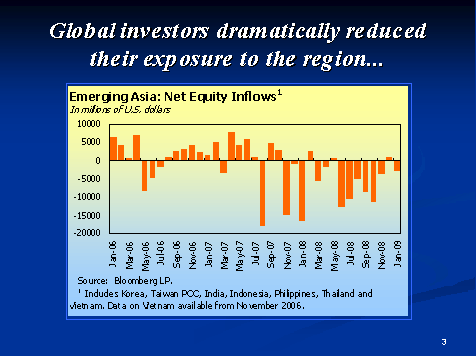
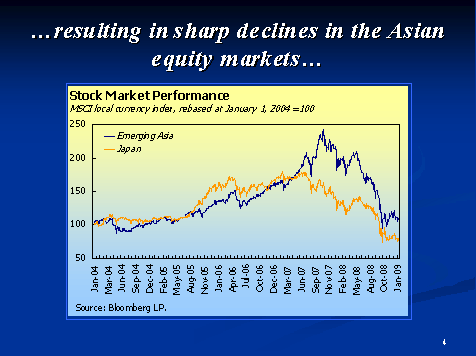
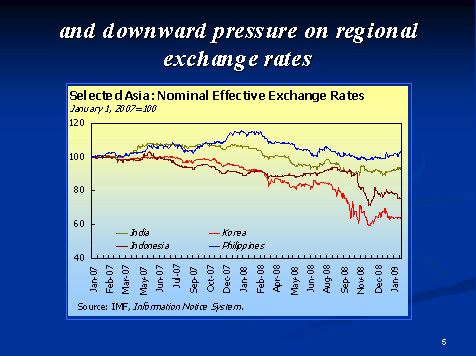
As a result, credit conditions have become tighter and financial markets remain very volatile.
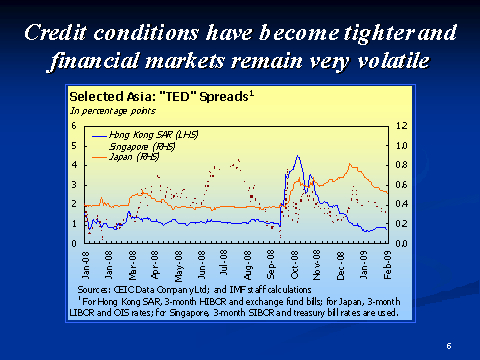
Then, as demand collapsed in the West, exports and industrial production have fallen off the proverbial cliff.
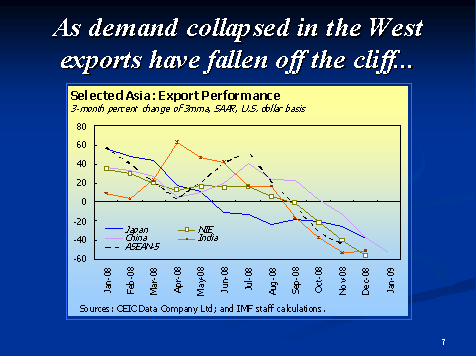
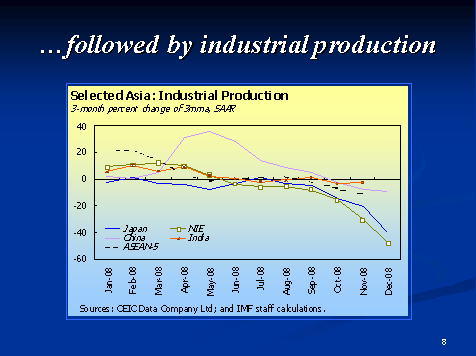
Output growth has decelerated quickly-with Japan, Hong Kong SAR, and Singapore already in "technical" recession and Korea experiencing the biggest quarterly decline in GDP growth since the Asian financial crisis. Leading indicators depict further gloom ahead.
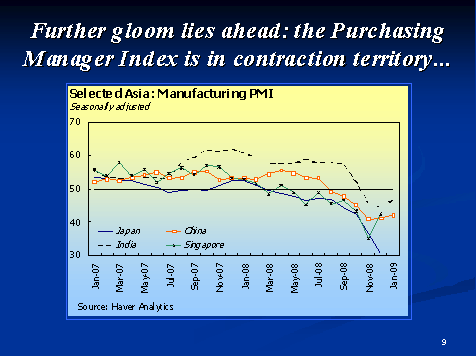
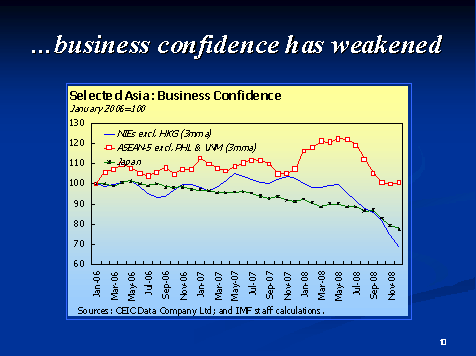
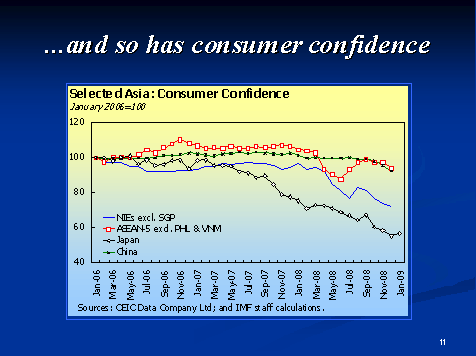
The speed and ferocity with which the global financial crisis has spread to Asia has caught many by surprise, casting doubt on the credibility of the three myths. How could so many people have been so wrong?
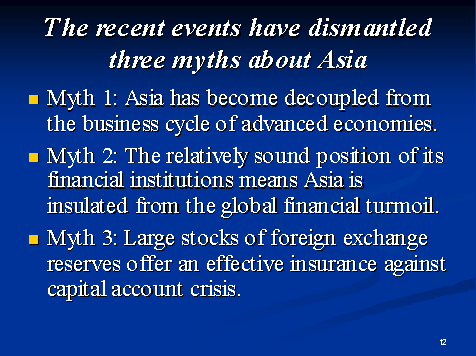
• Myth 1: Emerging economies in Asia are decoupled from the business cycle of advanced economies. The rapid expansion of intra-regional trade over the last decades seemed to suggest that Asia's reliance on external trading partners had diminished. But this was a mistake. In reality, global demand still represents a major factor behind Asia's export growth. Indeed, the relationship between U.S. (non-oil) import growth and Asian intra-regional export growth has actually become stronger over time.
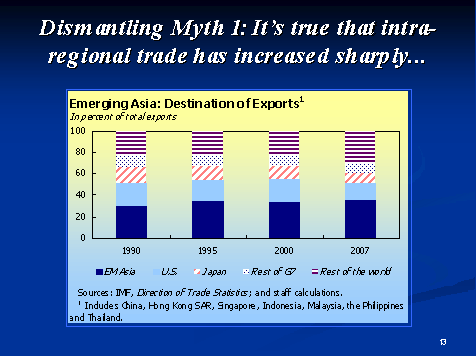
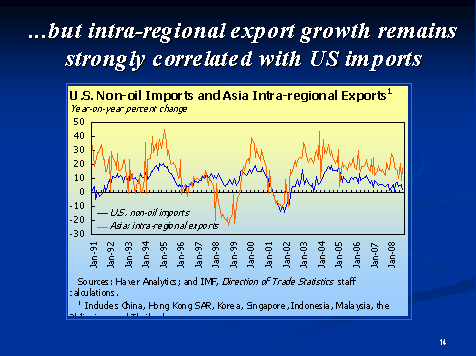
That's because of the nature of intra-Asian trade. Over the years, Asia has become integrated into a global supply chain. So, a large fraction of trade within the region reflects intra-industry processing and assembly through vertically integrated production chains. Correcting for this intra-industry trade shows that the total trade exposure of Asia to the United States and Europe has increased over time. And because exports are such a high share of Asia's GDP, the region is actually more exposed to shocks in advanced economies than other regions.
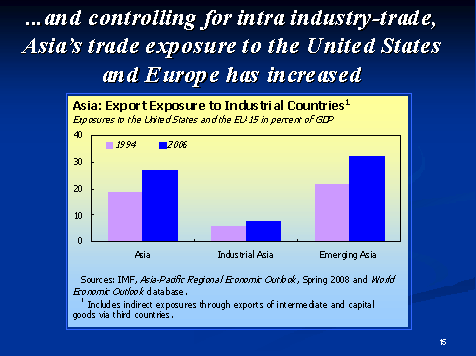
• Myth 2: Asian economies are insulated from the global financial turmoil: Asian financial institutions entered the global financial crisis with limited exposure to subprime-related instruments, and most had relatively healthy financial positions and strong capital buffers. Still, the dramatic increase in Asian participation in international financial markets has led to several channels of transmission of the global financial turmoil to the region.
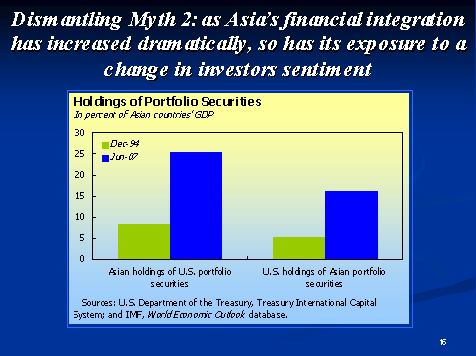
First, because foreign investors increased their holdings of Asian assets during the boom, the outflows during the crisis have been quite substantial. Outflows from equity markets alone in emerging Asia are estimated to have amounted to about 70 billion U.S. dollars in 2008. Second, the increased reliance of banks on international wholesale funding made them particularly exposed to the process of global deleveraging and the resulting shortage of dollar funding.
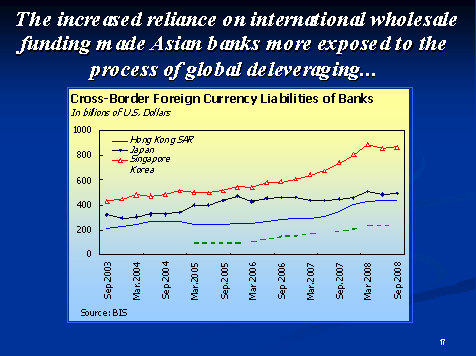
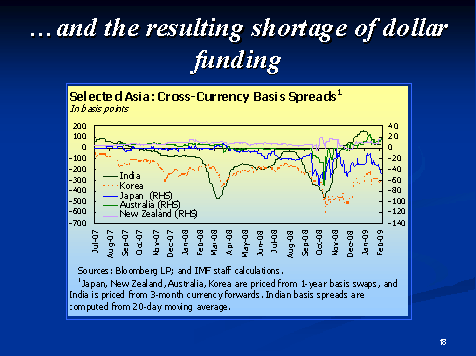
Third, since Asian corporates increased their reliance on foreign funding (bond, equity and loan issuance) during the boom period, they are more exposed to refinancing risks now that access to foreign borrowing has dried up.
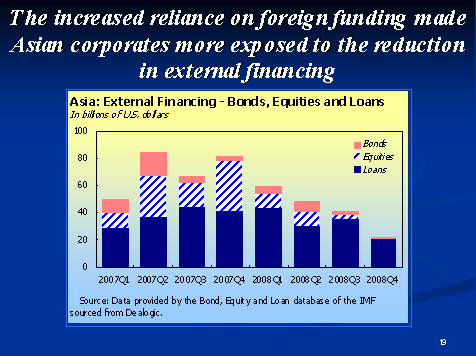
This has forced Asian corporates to delay new external bond issuances, refinance at shorter maturities or turn to domestic sources for funding-at a time when domestic credit has also tightened. Trade credit in particular has been reduced, something that at least partly explains the collapse of trade flows in the region.
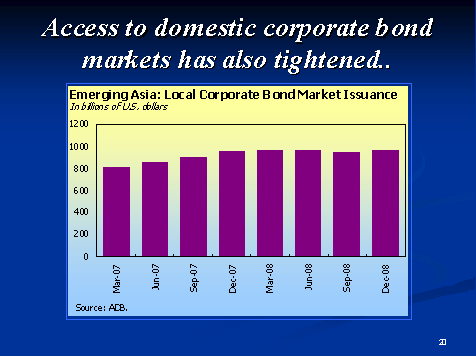
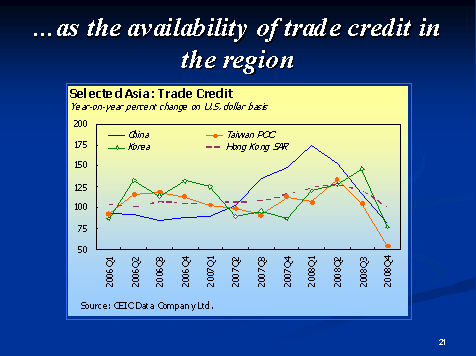
• Myth 3: Large stocks of foreign exchange reserves offer an effective insurance against capital account crisis. The reality is that reserves are useful-but only up to a certain point. The vast build-up of Asian reserves during the past decade certainly came in handy during the massive wave of the financial turmoil last September-November. At that time, countries were able to draw on these cushions to ease the strains from the dollar shortages and slow down currency depreciations. But as I've just explained, the high levels of reserves were not able to insulate Asian economies-the real and financial strains in the West were still transmitted to Asia. Moreover, if capital outflows by non-residents or residents continue, a further decline in reserves may have serious confidence effects, spurring further outflows. Overall, the current situation demonstrates that even countries with large war chests can not fully insure against a "sudden stop" of capital inflows.
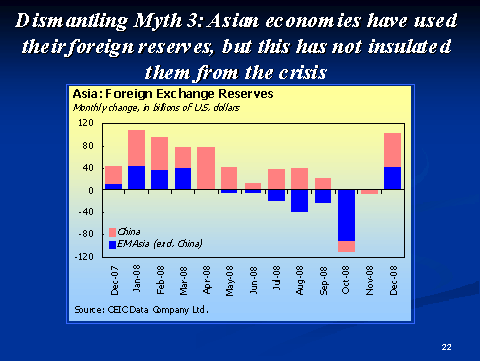
Economic Outlook: The View From the Fund. Two weeks ago the IMF released its update of the World Economic Outlook.
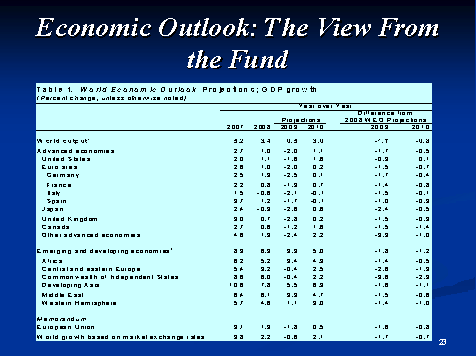
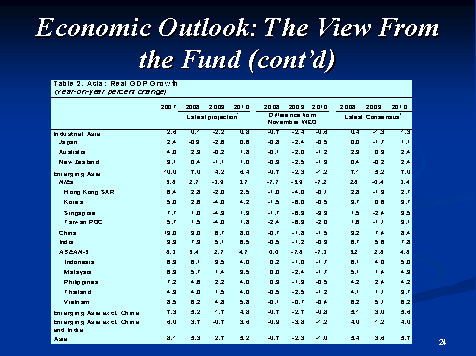
Let me summarize its main points:
• Global growth is projected to decline sharply to just ½ percent in 2009, the lowest rate since World War II. That's a far cry from the 5 percent rate recorded in 2007.
• In fact, output in the advanced countries will contract this year, for the first time in the postwar period.
• Activity in emerging and developing economies is expected to slow sharply under the drag of falling export demand and financing, lower commodity prices, and much tighter external financing constraints. Given Asia's pervasive linkages to the global economy we have marked down growth projections for the region significantly: average growth in 2009 for Asia is likely to be about 2.7 percent, about two-and-one quarter percentage points below our projections in November 2008.
Against rapidly deteriorated global economic outlook, the policy responses to date appear broadly adequate, more may need to be done in the quarters ahead.
• Monetary policy remains an important policy lever in some countries, even after the recent round of interest rate cuts and liquidity improvements.
• In these conditions, a key support to domestic demand must come from the implementation offiscal stimulus. Of course, not all countries can undertake fiscal stimulus, or do more than already done on this front, as higher deficits could pose great risks to their creditworthiness. But this makes all the more important that those countries that have fiscal room for maneuver do their part.
• Not less important is the challenge for the regulatory authorities in ensuring the financial system remains well capitalized and thatthe risks of a credit crunch are minimized. Of key importance is the need to ensure that sufficient tools exist to inject public capital into troubled institutions, ensure that the incentive framework encourages early loan loss recognition, and to resolve difficulties at an early stage before they become systemic or cause contagion to otherwise healthy institutions.
What Role for the IMF? Over the last three months, the Fund has provided substantial support to Hungary, Iceland, Pakistan, Ukraine, Latvia and Belarus and we are currently engaged in negotiations and discussions with several other member countries.
The deepening of the crisis required the IMF to broaden its approach by introducing a new facility for countries with sound policies but which are facing a temporary shortage of liquidity, owing to restricted access to international capital markets. The new lending instrument-called the Short-term Liquidity Facility (SLF)-provides fast, short-term access to large amounts of financing to members with strong fundamentals and track records of successful implementation, and carries no ex-post conditionality. Furthermore, the IMF is currently undertaking a major review of its lending instruments with a view to better respond to the evolving needs of the member countries.
Before closing, let me say a few words about a somewhat longer-term issue raised by the global financial crisis. It is now widely recognized that the current crisis has demonstrated the need for better early warning capabilities and a more carefully analysis of vulnerabilities and risks in the economies of advanced and emerging market countries alike. It is not difficult to predict that, in the post-crisis global economy, the Fund will play a key role in intensified collaboration with the Financial Stability Forum in developing less fragmented and more pointed early warning capabilities.
Thank you for your attention. I look forward to your questions and comments.
IMF EXTERNAL RELATIONS DEPARTMENT
| Public Affairs | Media Relations | |||
|---|---|---|---|---|
| E-mail: | publicaffairs@imf.org | E-mail: | media@imf.org | |
| Fax: | 202-623-6220 | Phone: | 202-623-7100 | |


